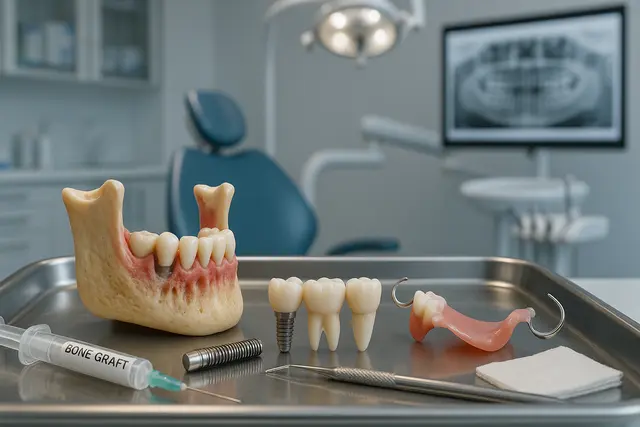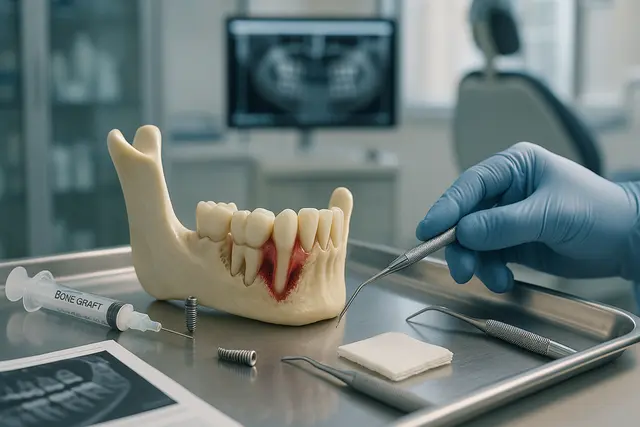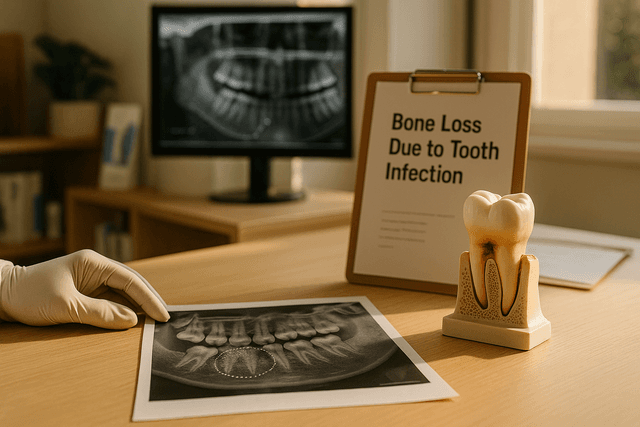Oral Health
4 min read
Sep 26, 2025
Tooth Replacement Options to Prevent Bone Loss
Losing a tooth isn’t just about appearance, it can have a lasting impact on your oral health, jawbone strength, and overall quality of life. When teeth go missing, the jawbone begins to shrink, which can change your bite, your facial structure, and even your confidence. Fortunately, modern dentistry offers several effective solutions to replace missing teeth and prevent further bone loss.

So you lost a tooth. Or maybe several. It's more common than you'd think, and no, it's not just about looks. When a tooth is lost, your jawbone starts to shrink. This isn’t just a minor inconvenience; it affects your oral health, how your face looks, and your ability to eat and speak with ease. The sooner you know your options for replacing missing teeth, the better chance you have to prevent bone loss and restore your smile for good.
Dental Implant Solutions That Go Deeper Than the Surface
A dental implant isn’t just a fancy tooth cap. It’s a small titanium screw placed into your jawbone, designed to mimic a real tooth root. Once healed, it becomes the foundation for a prosthetic tooth that looks and feels like the real deal. Unlike a dental bridge or partial dentures, implants don’t rely on neighboring teeth for support.
Here’s the best part: dental implants stop bone loss. They stimulate the jaw like bone needs, preventing the slow deterioration that happens when teeth go missing. It’s not magic, it’s solid science and clever engineering.
Dental implants help you:
Maintain bone density
Avoid relying on other teeth
Eat and smile with confidence
Restore your facial structure
With proper care, implants can last a lifetime. That’s a permanent solution worth smiling about.
How Tooth and Bone Loss Go Hand in Hand
Tooth loss isn’t just a cosmetic issue. Once a tooth is lost, the jawbone loss that once held it begins to shrink. This jawbone loss can lead to shifting of adjacent teeth, bite problems, and even changes in your facial shape over time.
Missing teeth can cause:
Bone loss in the jaw
A sunken facial appearance
Trouble chewing or speaking
Gum issues and increased dental problems
And the longer you wait to address it, the more bone you can lose, sometimes to the point where placing implants becomes tricky.
What to Know About Replacing Missing Teeth
If you’re dealing with one or more missing teeth, you have choices. Some quick options for replacing missing teeth include:
Removable dentures: A classic, cost-effective choice, but they don’t prevent bone loss.
Partial dentures: Good for replacing a few teeth, but also removable and less secure.
Dental bridges: Fixed in place, but they require grinding down adjacent healthy teeth.
Dental implants: The only option that can help prevent bone loss while giving you natural-looking, permanent teeth.
Bottom line: replacing missing teeth sooner rather than later helps protect your oral health long-term. And implants are designed to mimic real teeth in function and feel, which most patients prefer.
When Severe Bone Loss Complicates Things
Here’s where it gets tricky. If you’ve had missing teeth for a while, there may not be enough bone left to place a traditional implant. This is common, and it’s fixable.
Severe bone loss may mean you need:
Bone grafting: Adding bone or bone-like material to build up the area so implants can be placed.
Zygomatic implants: If bone grafting isn’t an option, zygomatic implants are an alternative. These are longer implants that anchor in your cheekbone instead of your jawbone, giving support where traditional implants can’t.
Your Dental Implant Consultation and What to Expect
Ready to take the next step? A dental implant consultation gives you a full picture of what’s going on in your mouth and what your best options are.
During this appointment, your dentist will:
Check your bone density and gum health
Discuss the benefits of dental implants
Review any dental issues that may affect implants
Create a personalized treatment plan just for you
They’ll also explain the type of implant you may need, whether traditional or zygomatic, and talk through the process step by step.
Choosing the Right Option for Tooth Replacement
Not every patient needs the same solution. Some may do great with a dental bridge. Others need full mouth dental implants or bone grafting first. The best option depends on your:
Bone condition
Number of missing teeth
Oral health history
Personal goals and lifestyle
A great dentist will talk you through every option for tooth replacement, including the pros and cons of each. Your comfort and long-term success should always come first.
The Many Benefits of Dental Implants
Let’s wrap this up with some feel-good facts. Dental implants aren’t just about replacing a tooth, they’re about getting your life back.
The benefits of dental implants include:
Restored ability to chew all your favorite foods
A beautiful, natural-looking smile
Protection against future bone loss
No need to rely on neighboring teeth
Improved speech and comfort
Boosted self-esteem
And yes, with good hygiene and regular checkups, dental implants can last a lifetime
That’s why so many patients are turning to this powerful solution to tooth loss.
What Are the Main Options for Replacing Missing Teeth With Bone Loss?
Patients with bone loss have several replacement options, including dental implants, partial dentures, full dentures, or bridges. Traditional dental implants are ideal because they mimic natural tooth roots and prevent further bone loss, but if bone density is too low, alternatives such as bone grafting or zygomatic implants may be recommended. Dentures and bridges restore appearance and function but do not stop jawbone shrinkage.
How Does Tooth Loss Lead to Bone Loss in the Jaw?
When a tooth is lost, the jawbone that once supported it no longer receives stimulation from chewing. Without this stimulation, the bone begins to shrink in a process called resorption. Over time, this can cause shifting teeth, bite misalignment, gum issues, and even a sunken facial appearance. Addressing tooth loss quickly helps prevent severe bone loss and makes replacement treatments easier.
Can Dental Implants Still Work If I Have Severe Bone Loss?
Yes, dental implants can often still be an option even with severe bone loss, though additional procedures may be needed. Bone grafting rebuilds lost bone so implants can be placed securely. For patients who cannot undergo grafting, zygomatic implants, anchored in the cheekbone instead of the jaw, offer an alternative. These solutions allow many patients once considered “not candidates” for implants to successfully restore their smiles.
Why Are Dental Implants Considered the Best Option for Tooth Replacement?
Unlike dentures or bridges, dental implants fuse with the jawbone and act like natural tooth roots. This stimulation prevents further bone loss, maintains facial structure, and provides unmatched stability for chewing and speaking. Implants also do not rely on neighboring teeth for support, protecting healthy teeth from unnecessary wear. With good care, they can last a lifetime, making them both a functional and long-term investment in oral health.
Read Next
Related Posts

Oral Health
Understanding Bone Loss in Teeth: Causes and Treatments That Work
Bone loss in teeth is a silent threat that can compromise your smile, facial structure, and overall oral health. While it often goes unnoticed in the early stages, it can lead to serious consequences if left untreated. Understanding what causes dental bone loss, and how to prevent or manage it, is key to maintaining a strong, healthy foundation for your teeth.
5 min read
Sep 25, 2025

Oral Health
Bone Loss Due to Tooth Infection Explained: What It Means for Your Oral Health
A tooth infection isn’t just about pain, it can quietly damage the tissues around a tooth and even erode the jawbone that supports your smile. This guide explains how infections start, why they can lead to bone loss, the warning signs to watch for, and the treatments that can stop the spread and rebuild lost support.
5 min read
Sep 25, 2025

Oral Health
What Is Mewing Trend? Origins, Science, and Results
From TikTok tutorials to teen slang, "mewing" has taken over the internet as the latest beauty and wellness craze. But beyond the social media hype, what exactly is mewing, and can it really transform your face or improve your jawline? This curious trend centers on one simple thing: where you rest your tongue.
4 min read
Sep 08, 2025
Don’t have time to research every dentist around you?
See why 30k+ patients trusted us